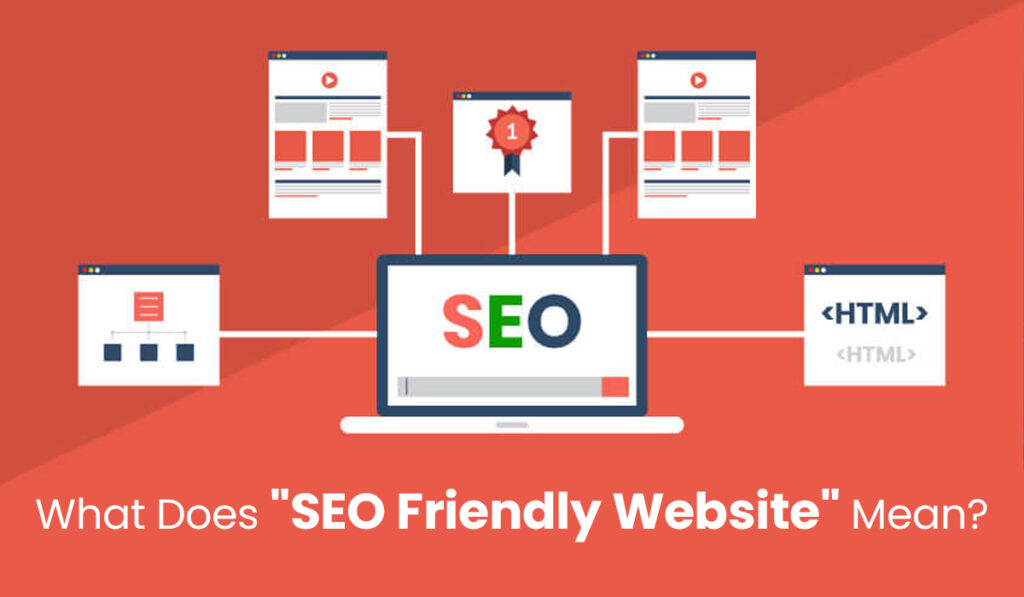Building a website is a critical step to connecting with the internet audience. But, if it isn’t properly optimized, it may fail to achieve its goals. An important component of website construction is search engine optimization (SEO), which tries to simplify the process for search engines to discover, index, and rank your website. You may improve your online presence, draw more visitors, and eventually accomplish your business objectives by optimizing your website for search engines. This step-by-step guide will demonstrate how to optimize your website for search engines.
Each company or person wishing to develop an online presence in the modern world must have a website. A website alone is insufficient to draw visitors and accomplish your online goals.
The success of your website in reaching your target audience depends on search engine optimization (SEO), which is essential. You raise your probability of ranking higher on search engine result pages (SERPs), bringing in more visitors, and accomplishing your business goals by making your website SEO-friendly. In this post, we’ll go over a step-by-step process for optimizing your website for search engines, including crucial topics like keyword research, content strategy, website loading speed, meta tags, URL optimization, backlinking, mobile friendliness, and website performance analysis. This article will provide the knowledge you need to build an effective, SEO-friendly website, whether you’re new to SEO or want to raise your website’s ranking.
What is SEO?

Search engine optimization is referred to as SEO. A website is optimized during this procedure to increase its exposure and rating on search engine result pages (SERPs). The goal of SEO is to make it simpler for search engines to comprehend a website’s content and connect it with pertinent search queries. Individuals and businesses can expand their online presence, draw more visitors, and accomplish their online objectives by optimizing their websites for SEO. SEO combines on-page and off-page optimization strategies, including keyword research, content optimization, backlinking, website performance analysis, and more.
The Importance of SEO

SEO is crucial because it helps organizations and people increase their online presence, attract customers, and accomplish their online goals.
If you also want to know about the Types of SEO we have also mentioned some points.
A well-optimized website is essential to standing out from the crowd and connecting with the correct audience in the age of fiercer online competition. SEO raises a website’s position on search engine result pages by assisting search engines in comprehending the website’s content and matching it with pertinent search queries (SERPs). Businesses and people can draw more organic traffic, which results in a greater conversion rate to leads or customers, by placing higher on SERPs. By enhancing website loading times, usability, and mobile responsiveness, SEO also contributes to better user experiences. Ultimately, SEO is crucial for establishing online success and continuing to be competitive in the digital era.
What Does “SEO Friendly Website” Mean?

An SEO-friendly website will score higher in search engine results (SERPs). An SEO-friendly website complies with best practices and rules to make it simple for search engines to crawl, index, analyze, and comprehend its material. Users can easily navigate the website because of its user-friendly structure and design. Target keywords, high-quality content, meta descriptions, and other on-page optimization strategies are used to improve the relevance, authority, and trustworthiness of an SEO-friendly website. A website must be SEO-friendly to enhance traffic, boost online visibility, and keep up with the competition.
Making Your Website SEO-Friendly Step-by-Step Procedure

A step-by-step process can help guarantee you cover all the essential components while optimizing your website for search engines. By adhering to an organized process, you can raise your website’s visibility online, rank higher on search engine result pages (SERPs), and draw more visitors and potential consumers to your website. Some essential aspects include keyword research, optimizing your content, enhancing your website’s loading speed, utilizing meta tags, optimizing your website’s URLs, constructing quality backlinks, ensuring mobile responsiveness, and assessing and tracking your website’s performance. You may boost your website’s online visibility and search engine optimization by taking a step-by-step strategy.
1. Do Keyword Research
Decide which terms and phrases your target market uses to look for goods and services in your specialized market. Your chances of appearing higher on search engine result pages will increase if you use this to optimize your content and meta tags to fit the search queries (SERPs).
A crucial step in building a search engine-friendly website is conducting keyword research. Finding the terms and phrases your target market uses to search for goods and services within your niche is known as keyword research. You may increase your chances of appearing better on search engine result pages by doing keyword research and optimizing your website’s content & meta tags to fit the search queries (SERPs).
As a result, you may generate more specialized and distinctive content that stands out by using keyword research to find your rivals’ phrases. You may find the ideal keywords for your website using one of the many keyword research tools accessible, like Google Keyword Planner, Ahrefs, and SEMrush. Ultimately, keyword research is an essential component of SEO that aids in increasing both the exposure of organizations and individuals online and their ability to draw in more customers.
2. Optimize Your Content
Create optimized material of the highest caliber, educational, and interesting, incorporating the desired keywords. A well-structured material with headers, subheadings, & bullet points will make it easier to read. To boost your website’s ranking, ensure that your material is original, pertinent, and frequently updated.
Making your website SEO-friendly requires carefully optimizing its content. To optimize your content, you must produce high-quality, pertinent, and interesting material that focuses on the keywords you found throughout your keyword research. Both consumers and search engines should be able to easily read, understand, and use the content.
The authority and credibility of the website can be increased by including internal and external connections to relevant pages and websites. Also, including the target keywords in the header tags, meta descriptions, and title tags can help search engines better grasp the website’s content and raise its rating on SERPs. Content optimization efforts should also center on meeting users’ needs and fulfilling their search intentions to maximize user engagement and improve website performance.
3. Improve Website Loading Speed
A website’s loading speed heavily influences user experience and SEO ranking. Ensure that your website loads quickly and that your images and videos are optimized for the online.
A key component of making your website SEO-friendly is performance improvements. High bounce rates and decreased website performance are two consequences of a slow-loading website that can harm the user experience. Considering that search engines prefer websites offering a better user experience, slow-loading websites are also likely to appear lower on search engine result pages (SERPs).
Images and other media assets can be compressed, HTTP requests can be minimized, content delivery networks (CDNs) can be used, website caching can be optimized, and the use of plugins on websites can be reduced, which will speed up website loading. Also, you can evaluate the performance of websites and find areas for improvement using tools for website speed testing like Google PageSpeed Insights and GTmetrix. Increasing the speed at which your website loads is essential for optimizing SEO and visitor experience.
4. Use Meta Tags
Search engines receive critical information about your website through meta tags. To make it simpler for search engines to comprehend what your website is about, use header tags, meta titles, and meta descriptions on all of its pages.
Making your website SEO-friendly involves using crucial meta tags. Meta tags are HTML components that educate website users and search engines about a webpage. The title, meta description, and header tags are among the most crucial meta tags. The title tag should be optimized with the goal keywords and concise summary of the webpage’s content because it appears in search engine result pages (SERPs).
The webpage’s content is briefly summarized in the meta description, shown beneath the title tag. It should also contain relevant keywords and an engaging call-to-action to persuade visitors to click on the website. The usage of header tags, with H1 being the most significant and H6 being the least, allows for the organization of the material and the establishment of hierarchies.
A website’s score on search engine results pages can be increased by optimizing the meta tags with the desired keywords to assist search engines in better understanding the content. Using meta tags is essential for optimizing your website for search engines and increasing its online visibility.
5. Optimize the URLs for Your Website
Ensure that the URLs for your website are brief, clear, and include pertinent keywords. With your URLs, avoid utilizing underscores, numerals, or special characters, as they can cause search engines to become confused and have a difficult time indexing your content.
Making your website SEO-friendly requires optimizing the URLs. Creating descriptive, user-friendly URLs that contain the desired keywords and appropriately reflect the webpage’s content is known as URL optimization. A well-optimized URL is simple to read and comprehend, enhancing user experience and persuading visitors to visit the website.
A website’s rating on search engine result pages can be increased by optimizing the URLs with the desired keywords because search engines utilize URLs to comprehend the content of a webpage (SERPs). Use hyphens to separate words in your website’s URLs, avoid utilizing digits and other special characters, and keep your URLs brief and to the point. Making your website SEO-friendly and increasing its online visibility requires optimizing the URLs.
6. Create High-Quality Backlinks
Links pointing to your website from other websites are known as backlinks. Your website’s rating and online visibility can benefit from high-quality backlinks from reliable websites. Provide interesting, educational material that other websites will want to connect to if you want to earn great backlinks.
To make your website SEO-friendly, you must first build high-quality backlinks. Backlinks, or links pointing to your website from other websites, are crucial for increasing the authority and reliability of the website. Websites with more high-quality backlinks typically appear higher on search engine result pages because search engines utilize backlinks to assess a website’s quality and relevance (SERPs).
High-quality, pertinent, and interesting content can draw visitors to other websites and persuade them to link to your website, which can help you establish excellent backlinks. A backlink can also be obtained by contacting other website owners or participating in link-building activities like guest posting, fixing broken links, and social bookmarking. Creating high-quality backlinks is crucial to making your website SEO-friendly & increasing its online visibility.
7. Ensure Mobile Responsiveness
More than 50% of web users access the web using mobile devices. Ensure your website is mobile-friendly to enhance user experience and increase your SEO position.
To make your website SEO-friendly, it’s crucial to ensure it is mobile-responsive. The term “mobile responsiveness” describes a website’s capacity to adjust to various screen sizes and devices, giving users a seamless surfing experience regardless of their device. Search engines emphasize mobile-responsive websites since more people are using mobile devices to access the internet, and these websites typically rank higher on search engine result pages (SERPs).
You can employ responsive web design to ensure mobile responsiveness, which modifies the website’s appearance and content to fit the mobile device’s screen size. To find areas for improvement and to mobile-optimize your website, you may also use tools for mobile optimization like Google’s Mobile-Friendly Test. Ensuring your website is mobile-responsive is essential for increasing its SEO friendliness and online visibility.
8. Analyze and Monitor Your Website’s Performance
Evaluate and keep track of the performance of your website by using SEO tools like Google Analytics regularly. Identify areas that require improvement by analyzing the data, then make the necessary adjustments to your SEO approach.
Making your website SEO-friendly requires analyzing and tracking its performance. You may identify opportunities for improvement, track your website’s position on search engine result pages (SERPs), and gauge the effectiveness of your SEO efforts by keeping an eye on your website’s performance.
To examine your website’s performance and track important metrics like traffic, bounce rates, page load times, & conversion rates, you may use various SEO tools like Google Analytics, SEMrush, and Ahrefs. You can further optimize your website to increase its functionality and online presence based on the insights you acquire. Making your website SEO-friendly and accomplishing your SEO objectives require constant analysis and monitoring of its performance.
Conclusion
In conclusion, optimizing your website for search engines requires a systematic process that includes several crucial phases. Making your website SEO-friendly involves many crucial procedures, including conducting keyword research, optimizing your content, enhancing website loading times, utilizing meta tags, optimizing URLs, constructing high-quality backlinks, guaranteeing mobile compatibility, and assessing and tracking your website’s performance.
Hence, optimizing a website for search engines requires both on-page and off-page strategies. You may raise the rating of your website on search engine results pages (SERPs), draw in more users, and accomplish your business goals by taking the actions described above. In addition to keeping up with the most recent SEO developments and best practices, keep your website updated frequently with interesting, fresh material.
FAQ’s

Question 1: Why is keyword research so important for optimizing your website for search engines?
Finding pertinent keywords and phrases people use to look up information connected to your website is a process known as keyword research. Making your website SEO-friendly requires conducting keyword research since it enables you to comprehend your target audience & their search intent and to optimize the content of your website with relevant keywords to increase its relevance and exposure on search engine result pages (SERPs).
Question 2: Why is SEO website speed optimization essential?
The speed at which your website loads is crucial for SEO because search engines prefer websites that offer a better user experience. High bounce rates, poor user engagement, and decreased online exposure are all consequences of slow-loading websites.
To enhance user experience, lower bounce rates, and boost your website’s rating on search engine results pages, it is essential to optimize the loading speed of your website.
Question 3: What are meta tags, and how can they help to make your website SEO-friendly?
The HTML component, known as a meta tag, tells search engines anything about the content of your website. Meta descriptions, header tags, and title tags are some of them. By providing search engines with pertinent information about the content of your website, meta tags assist in making your website SEO-friendly, which helps to increase your website’s rating on SERPs and drive more traffic to it.
Question 4: How can I get high-quality links pointing to my website?
High-quality, pertinent, and interesting content can draw visitors to other websites and persuade them to link to your website, which can help you establish excellent backlinks. Also, you can request backlinks from other website owners or participate in link-building activities like guest posting, fixing broken links, and social bookmarking.
Question 6: What can I do to make my website mobile-friendly?
Responsive web design, which alters the website’s appearance and content to fit the display size of the device being used, can be used to ensure mobile responsiveness. To discover improvement areas and mobile-optimize your website, you may also use tools for mobile optimization like Google’s Mobile-Friendly Test.
Question 7: Why are performance monitoring and analysis beneficial for my website?
It’s crucial to analyze and keep track of your website’s performance to pinpoint areas that need development, monitor your website’s position on search engine results pages, and gauge the effectiveness of your SEO campaigns. You may make data-driven decisions and further optimize your website to enhance performance & online visibility by tracking and evaluating its performance.

